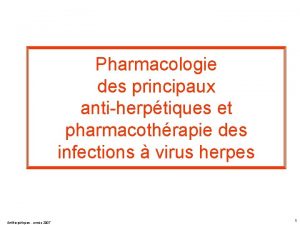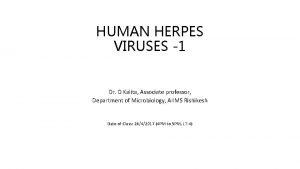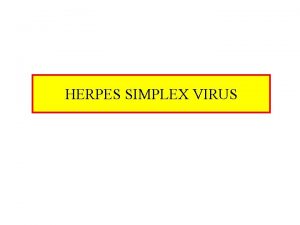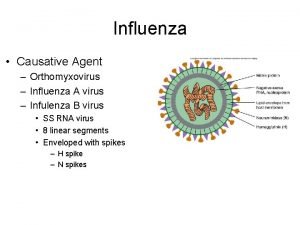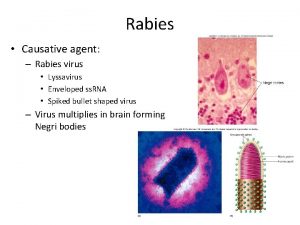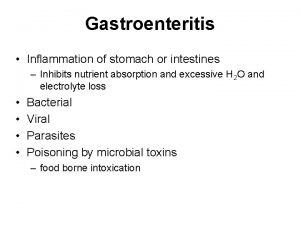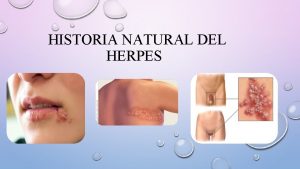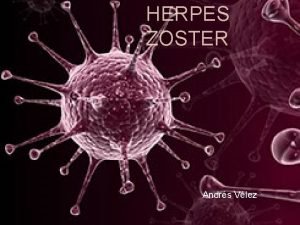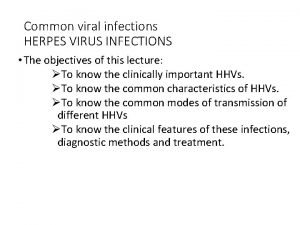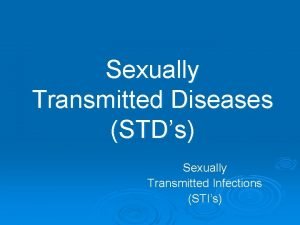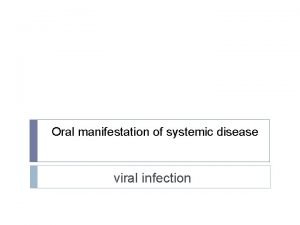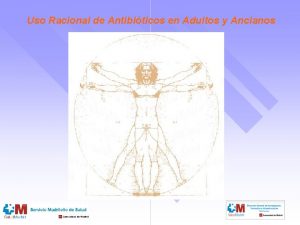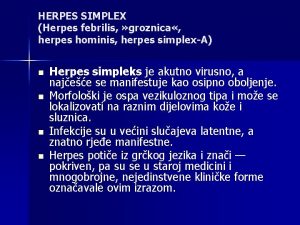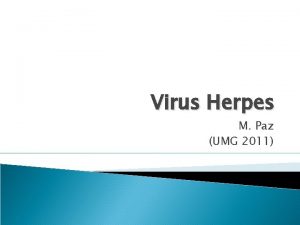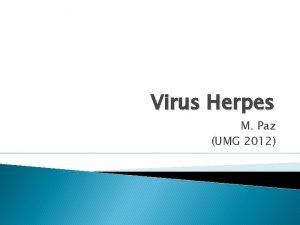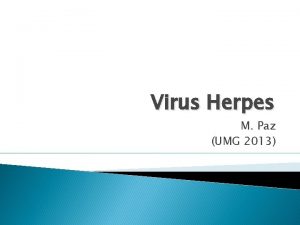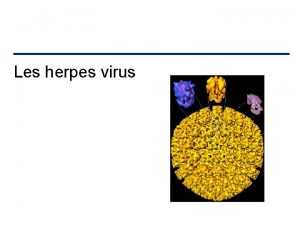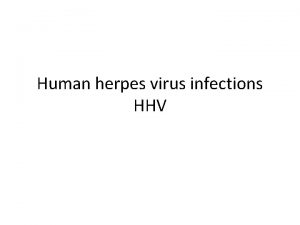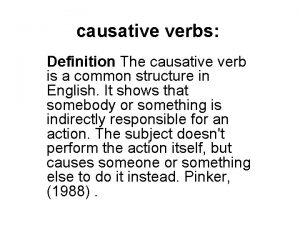Chickenpox Causative agent VaricellaZoster virus Herpes virus One






![[INSERT DISEASE AT A GLANCE 19. 7] [INSERT DISEASE AT A GLANCE 19. 7]](https://slidetodoc.com/presentation_image/3fb7617a248b4d7883115c2e16d6d52d/image-7.jpg)










![[INSERT TABLE 19. 4] [INSERT TABLE 19. 4]](https://slidetodoc.com/presentation_image/3fb7617a248b4d7883115c2e16d6d52d/image-18.jpg)










![[INSERT TABLE 19. 5] [INSERT TABLE 19. 5]](https://slidetodoc.com/presentation_image/3fb7617a248b4d7883115c2e16d6d52d/image-29.jpg)


- Slides: 31

Chickenpox • Causative agent – Varicella-Zoster virus – Herpes virus • One of the most common rashes among children – More serious in adults

• Signs& Symptoms – Skin rash appears on body trunk then spreads to face, neck and limbs • Rash is diagnostic • Itchy rash progresses from red spots to pus filled blisters that break and crust over – Viral incubation period approximately 2 weeks • Infective 1 to 2 days before rash until all blisters crust

• Epidemiology – Disease transmitted by respiratory secretions and skin lesions – Virus typically enters through respiratory route, replicates and moves to the skin via blood stream – Infected cells swell and lyse • Release viruses which enter sensory nerves – Usually self limiting

• Sequella – Shingles or herpes zoster – Reactivation of latent virus – Virus in nerve cell replicates and moves back to skin – Linked with decline in immunity • Age, stress – Diagnosed by antibody test

• Prevention and treatment – Prevention directed at vaccination • Attenuated vaccine licensed in 1995 • Recommended for healthy individuals 12 months and older – Treatment is directed at alleviating symptoms • Acyclovir given in high risk cases

– Reye’s Syndrome – Associated with a number of viral infections – Linked to aspirin usage in children – Characterized by vomiting and coma » Liver and brain damage – Mortality around 30%
![INSERT DISEASE AT A GLANCE 19 7 [INSERT DISEASE AT A GLANCE 19. 7]](https://slidetodoc.com/presentation_image/3fb7617a248b4d7883115c2e16d6d52d/image-7.jpg)
[INSERT DISEASE AT A GLANCE 19. 7]

Measles • Causative agent – Rubeola virus – paramyxovirus

• Signs & Symptoms – Fever, runny nose, dry cough, conjunctivitis – Fine rash (maculopapular) • first on forehead – Koplik spots – Symptoms generally disappear within 1 week – May cause miscarriage and low birth weight

• Epidemiology – Humans are only natural host – Virus spread by respiratory droplets – Replicates in epithelium of upper respiratory tract • 8 -10 day incubation – Spreads to lymph becoming systemic – Typically self-limiting

– Many cases complicated by secondary infections • Pneumonia and earaches – Rare complications • encephalitis and subacute sclerosing panencephalitis (SSPE) • persistent viral infection

• Prevention and treatment – Prevention directed to vaccination • Vaccine is usually given in conjunction with mumps and rubella vaccine – MMR • Before routine immunization, over 99% of population infected • Measles are no longer endemic in US – No antiviral drug exists for rubeola infection • May treat with passive immunotherapy

German Measles • Causative agent – Rubella virus – togavirus • Typically mild • Difficult to diagnose

• Symptoms – – Slight fever with mild cold symptoms Enlarged lymph nodes behind ears and back of neck Faint rash (macules) Symptoms last only a few days

• Significant infection in pregnant women – Congenital rubella syndrome – May result in blindness, deafness, heart defects, mental retardation and low birth weight – Fetal injury varies based on the time of infection

• Epidemiology – Humans are only natural host – Virus spread by respiratory droplets – Multiplies in nasopharynx then enters blood – Disease is highly contagious • Infectious 7 days before appearance of rash and up to 7 days after it disappears

• Prevention and treatment – Vaccination with attenuated rubella virus vaccine • Administered at 12 months and boostered at 4 to 6 years of age • Produces long-lasting immunity
![INSERT TABLE 19 4 [INSERT TABLE 19. 4]](https://slidetodoc.com/presentation_image/3fb7617a248b4d7883115c2e16d6d52d/image-18.jpg)
[INSERT TABLE 19. 4]

Warts • Causative agent: – Papillomavirus – Causes small tumors called papillomas (warts) – Typically benign

• 50 different papillomaviruses known to infect humans – infect skin through minor abrasions – Direct, indirect or auto- inoculation – Viruses can survive on a number of fomites • Towels • Shower floors

• Treatment involves killing abnormal cells – Freezing – Cauterization – Corrosive chemicals – Surgical removal – Laser

Mycoses of the Integument • Most fungi are opportunistic pathogens • Mycoses classified by location – Superficial – hair, nails, and outer skin layers • most common – Cutaneous – in the skin – Subcutaneous – in the hypodermis and muscles – Systemic – affect numerous systems

• Superficial Mycoses – Pityriasis versicolor • Caused by Malassezia furfur • Endogenous

Pityriasis versicolor

– Pathogenesis • Superficial fungi produce keratinase, which dissolves keratin – Diagnosis, treatment, and prevention • Identified by green color under ultraviolet light and treated with topical or oral drugs – Tolnaftate; Griseofulvin; Azoles

• Cutaneous Mycoses – May manifest as cutaneous lesions – Dermatophytoses • Immune responses damage deeper tissues

• Causative Agent – Genera responsible for most dermatophytoses • Epidermophyton • Microsporum • Trichophyton – Collectively termed dermatophytes

Tinea capitis - scalp Tinea corporis – body (Ringworm) Tinea pedis foot (Athlete’s foot)
![INSERT TABLE 19 5 [INSERT TABLE 19. 5]](https://slidetodoc.com/presentation_image/3fb7617a248b4d7883115c2e16d6d52d/image-29.jpg)
[INSERT TABLE 19. 5]

– Excessive moisture allows invasion of keratinized tissue • Most dermatophytes produce keratinase – Scalp is invaded through hair follicle – Fungal products defuse to dermal layer and evoke an immune response

• Treatment, and prevention – Attention to cleanliness – Maintenance of dryness – Treat limited infections with topical agents • Tolnaftate – Treat widespread infections with oral drugs • Griseofulvin; terbinafine
 Herpes simplex virus
Herpes simplex virus Herpes simplex virus 2
Herpes simplex virus 2 Human herpesvirus 2
Human herpesvirus 2 Herpes simplex virus
Herpes simplex virus Hsv encephalitis
Hsv encephalitis Smallpox vs chickenpox
Smallpox vs chickenpox Diff between measles and chickenpox
Diff between measles and chickenpox Chickenpox vaccine schedule
Chickenpox vaccine schedule Chickenpox pathophysiology
Chickenpox pathophysiology Chickenpox
Chickenpox Infulenza
Infulenza Rabies causative organism
Rabies causative organism Gastroenteritis
Gastroenteritis Causative agent malaria
Causative agent malaria Kernig sign
Kernig sign Clavibacter
Clavibacter Differentiate between oxidation and reduction
Differentiate between oxidation and reduction What is oxidation agent
What is oxidation agent Reducing agent vs oxidizing agent
Reducing agent vs oxidizing agent Agent function vs agent program
Agent function vs agent program Agent function
Agent function Herpes gravid
Herpes gravid Herpes de boca
Herpes de boca Herpes zoster clasificacion
Herpes zoster clasificacion Herpes simpleksserotipe 2
Herpes simpleksserotipe 2 Herpes simpleksserotipe 2
Herpes simpleksserotipe 2 Tuba fallopi berfungsi
Tuba fallopi berfungsi Google imagens
Google imagens Herpes simplex
Herpes simplex Genial herpes
Genial herpes Herpes rugbiorum
Herpes rugbiorum Pitiriasis versicolor
Pitiriasis versicolor
